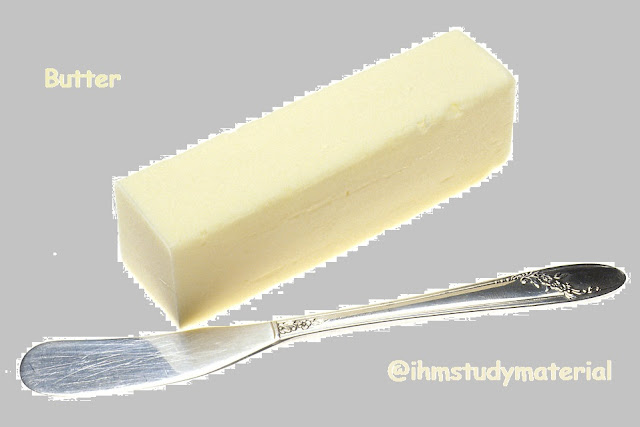BUTTER | BASIC COMMODITIES
 |
| Butter |
BUTTER
A. INTRODUCTIONButter is fatty substance obtained from churned cream, containing 80% fat, 20% water and whey (milk solids lift from separating process).
Butter hardens at low temperature and melts when heated.
The smoking temperature of butter is 127ºC.
Color varies form creamy white to golden yellow. It is the milk protein in the whey that makes butter spoil quickly.
Most of the butter is made form cow’s milk but other are some butter made from the milk of buffalo, yak, goatand sheep is also available.
B. PROCESSING OF BUTTER
1. HOLDING:
Cream is pasteurized for 2-4 seconds at 95º C and then the temperature is lowered to 4-5º C and that is kept for several hours to ensure uniform hardening of fat particles.
2. RIPENING:
When the end product is going to be Lactic butter, only then this step is carried out, in which bacterial
culture is added. In this case, the holding temperature will be 15-18º C for 3-4 hours before being cooled to 4-5º C.
This gives butter a good flavour and the stage is omitted while making sweet cream butter.
3. CHURNING:
It is carried out in big stainless steel containers holding about 100 gallons of cream and the internal
churners pass through the cream.
This breaks the layer of fat solids which are released and are combined to form a large group of butter fat.
After about 30 minutes of churning the butter gets separated from butter milk and floats to the
surface.
4. WASHING AND SALTING:
The butter grains are now washed with ice cold water to remove any butter milk left on
the surface of each grain, in order to maximize the keeping quality.
Salting is carried in two ways:
i. By adding fine grains of dairy salt.
ii. By dipping butter grains into brine solution (salt + vinegar) for 10-15 minutes and allowing the butter grains to absorb it.
There are two types of butter-
1. Sweet cream butter
2. Lactic butter.
Butter can be made from any kind of milk. In India, butter is made from buffalo milk.
Sweet cream butter :
It is also known as fresh cream butter and is made from unripened cream.
It can be salted or unsalted. It is soft, creamy texture and a creamy buttery taste.
Lactic butter :
This type of butter specially made in Denmark, Holland and France.
The cream is mostly pasteurized,inoculated with a culture that ripens the butter, then pasteurized once more to arrest the ripening process.
Uses of Butter
As a spread for bread, toast and scones
As a basic ingredient in pastry-making and cake-making.
Used as an accompaniment (compound butter).
To enhance the taste and flavour of soups and sauces.
As a cooking medium (The smoke point of butter fat is only 127-130°C; so a vegetable oil should be used when high cooking temperatures are required).
For butter sculptures.
Butter is available in 10 gm, 100 gm, and 500 gm packs in the market.
Notes :
Unsalted butter /sweet butter-
it has mild aroma and slightly sweet flavor, used for making sweet pastries and cakes.
Salted butter –
butter was originally salted to preserve it for the winter months when fresh butter was not made.
Today salted is added to butter as ingredients. It is not ideally used in preparation of pastries.
Compound butter :
these are made by adding a particular natural flavor or color to butter, depending on the type of food with which it is served. It is generally used as an accompaniment e.g. Lobster butter, parsley butter etc.
Ghee :
it is obtained by clarifying butter. Butter is heated to evaporate water. Pure ghee has a higher keeping quality and is a goo cooking medium and shortening agent used in Indian cuisine.
Differenciate between compound butter and salted butter.




No comments